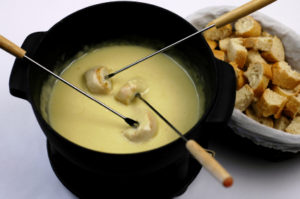Sometimes, even we are surprised by how beautiful cheese can be at times. Sometimes it’s the pattern of blue veining through a wheel of Bayley Hazen Blue, or maybe speckling of dappled herbs on the outside of a round of Hudson Flower. But nothing is as visually stunning as the bounty of rosettes we make whenever we break into a wheel of Tete de Moine.
Tete de Moine, which literally translates to “monk’s head”, dates back to 12th century, in the glorious Swiss Jura Mountains. It was developed by monks in the Bellelay monastery, who would use the cheese as a means of paying their taxes to the local government. The Bellelay abbey was founded in 1136 by Sigenarnd, the Provost of Munster Cathedral, which is now part of the Swiss Jura, and their main income came from their cheesemaking, which also helped feed their monks. While the cheese was originally known as “Bellelay Cheese” (first called that in 1570), it received the name Tete de Moine around the time of the French Revolution. The new name dates from around 1793-1799, and appears to have two separate origins:
Version one appears to be a nickname from the French Revolution as a reference to how the cheese is served by shaving directly from the wheel, revealing a ‘bald spot’ similar to the haircut the monks had. The second version refers to the fact that Jura tradition counted cheeses in the abbey per “monk’s head”, or by monk. The name, no matter what the origin, this delightful Alpline cheese has stuck around since, and was given AOP (appellation d’origine protégée) status. Currently, there are fewer than 10 cheese dairies in the Jura Mountains that are producing Tete de Moine, making it pretty rare!
But Tete de Moine came into the limelight stateside in 1982 with the invention of the girolle. The girolle, invented by Nicolas Crevoisier, is used for scraping Tete de Moine to form gorgeous rosettes of the cheese that resemble chantrerelle mushrooms – mushrooms that are known as girolle in French! Since then, Tete de Moine has become a centerpiece at parties and events. Easy to use, the girolle creates a beautiful and delicious presentation of a classic Alpine Swiss cheese. When Tete de Moine is shaved, the surface of the cheese that comes into contact with the air is increased. This helps the full, aromatic, melt-in-your-mouth taste to develop. Notes of dried fruit and toasty nuttiness become more intense, pairing well with a hearty, dry white wine.
Break out the girolle and start shaving a garden of rosettes from the Tete de Moine – you’ve never had a more beautiful cheese experience.


